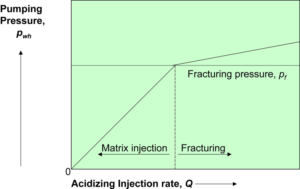Matrix acid treatment is one of the types of well production stimulation,  in which acid is injected into the reservoir at a pressure below the fracture pressure, in order to increase rock permeability or to treat and clean the bottom-hole area from contaminants. Improving well productivity is achieved by dissolving the acid composition of the rock. Depending on the type of reservoir (carbonate or clastic), HCL-acid or HF-acid treatment is carried out, respectively.
in which acid is injected into the reservoir at a pressure below the fracture pressure, in order to increase rock permeability or to treat and clean the bottom-hole area from contaminants. Improving well productivity is achieved by dissolving the acid composition of the rock. Depending on the type of reservoir (carbonate or clastic), HCL-acid or HF-acid treatment is carried out, respectively.
An important requirement is also the addition of special chemical additives to acid solutions, which influence the success of acid treatment they are corrosion inhibitors, dispersants, demulsifies, iron stabilizer, etc.
In certain cases of acidizing, coiled tubing equipment with special nozzles on the bottom-hole assembly is used to increase the quality of performed well interventions. For example, for the most optimal coverage of the whole productive interval of the well with the carbonate thickness over 40 m, it is better to conduct the acidizing with CT by pumping the acid solution through a special nozzle creating strong pulsating shocks on the bottomhole, thus achieving deeper penetration of the acid into the reservoir and reducing the risk of “absorption” of the acid by the highly permeable interval. In this case the ability to reciprocate the coiled tubing all along the perforated interval (up and down) and the effect of pulsating striking which reduce the delta of permeability of intervals, will play a significant role in the acidizing process. Video of CT downhole tool testing at KazGeoTech production facility:
KazGeoTech offers a comprehensive StimWell Service, including
- Selection of candidate wells for acidizing
- Acidizing process simulation with prediction of expected production results
- Laboratory tests with the use of core, oil of candidate wells
- Engineering support and more
